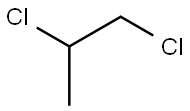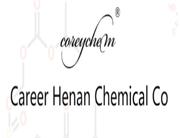| Chemical Properties |
colourless liquid |
| Uses |
1,2-Dichloropropane is a byproduct in the production of epichlorohydrin (E582310), an important industrial chemical, is a bifunctional alkylating agent with the potential to form DNA cross-links. |
| Uses |
Solvent for oils, fats, resins, waxes, rubber; in ion exchange manufacture; in photographic film production; paper coating; petroleum catalyst regeneration. Has been used as a soil fumigant. |
| General Description |
Colorless watery liquid with a sweet odor. Sinks in water. Produces an irritating vapor. |
| Air & Water Reactions |
Highly flammable. Insoluble in water. |
| Reactivity Profile |
1,2-Dichloropropane reacts with strong oxidizers and strong acids. 1,2-Dichloropropane also reacts with aluminum. When confined, this reaction can lead to an explosion. 1,2-Dichloropropane is incompatible with bases and aluminum alloys. 1,2-Dichloropropane will attack some forms of plastics, rubber and coatings. |
| Hazard |
Flammable, dangerous fire risk, explosive limits in air 3.4–14.5%. Toxic by ingestion and inhalation. Upper respiratory tract irritant and body weight effects. Questionable carcinogen. |
| Health Hazard |
Contact with skin or eyes may cause irriation. |
| Fire Hazard |
Special Hazards of Combustion Products: Toxic and irritating gases may be generated. |
| Safety Profile |
Suspected carcinogen with experimental carcinogenic data. Moderately toxic by inhalation and ingestion. Mddly toxic by skin contact. An eye irritant. Mutation data reported. Can cause liver, kidney, and heart damage. Can cause dermatitis. One of the more toxic chlorinated hydrocarbons. A suggested order of increasing toxicity is dichloromethane, trichloroethylene, carbon tetrachloride, dichloropropane, dichloroethane. Animals exposed to hgh concentrations often showed marked visceral congestion, fatty degeneration of the liver, kidney, and, less frequently, of the heart. They also showed areas of coagulation and necrosis of the liver. There was found to be a heavy mortality among mice exposed to 400 ppm concentrations. A flammable liquid and very dangerous fire hazard when exposed to heat or flame. Reacts with aluminum to form aluminum chloride. This reaction, when confined, can lead to explosion. Can react vigorously with oxidizing materials. To fight fire, use water, foam, CO2, dry chemical. When heated to decomposition it emits toxic fumes of Cl-. See also CHLORINATED HYDROCARBONS , ALIPH AT1 C |
| Purification Methods |
Distil the propane from CaH2. It has a limited shelf life. [Beilstein 1 IV 195.] |

 China
China







